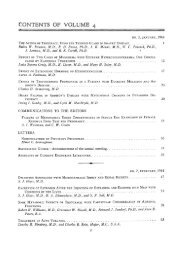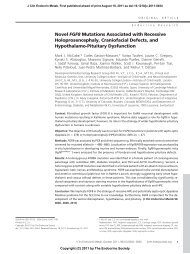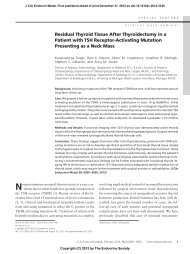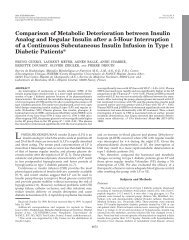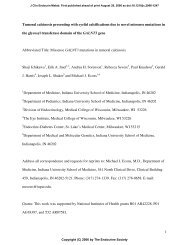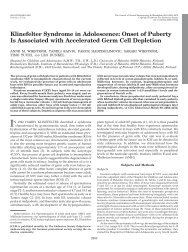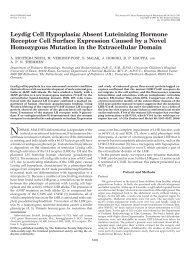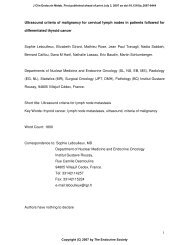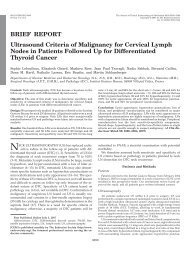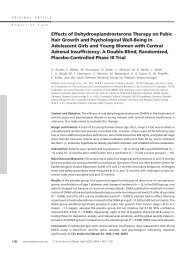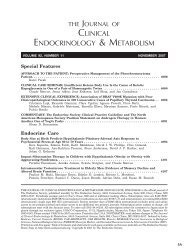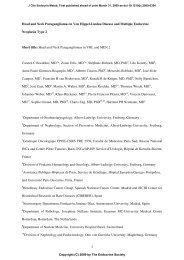Title: Neuropsychological Features in Primary Hyperparathyroidism ...
Title: Neuropsychological Features in Primary Hyperparathyroidism ...
Title: Neuropsychological Features in Primary Hyperparathyroidism ...
Create successful ePaper yourself
Turn your PDF publications into a flip-book with our unique Google optimized e-Paper software.
Introduction<br />
Classical PHPT was a symptomatic disease with commonly recognized neurologic, cognitive and<br />
psychiatric manifestations (1, 2). Many patients with PHPT are now asymptomatic or report only non-<br />
specific symptoms, <strong>in</strong>clud<strong>in</strong>g weakness, easy fatigability, depression, <strong>in</strong>tellectual wear<strong>in</strong>ess, loss of <strong>in</strong>itiative,<br />
anxiety, irritability, and sleep disturbance (3). While these symptoms are concern<strong>in</strong>g, they are difficult to<br />
quantify and there is debate about whether they are directly attributable to the underly<strong>in</strong>g disease. At the<br />
Third International Workshop on Asymptomatic <strong>Primary</strong> <strong>Hyperparathyroidism</strong> (4), studies on the<br />
psychological and cognitive features of PHPT were reviewed and not considered to be an <strong>in</strong>dication for<br />
parathyroidectomy (5). The workshop recognized <strong>in</strong>consistencies <strong>in</strong> the abnormalities described, their<br />
association with the underly<strong>in</strong>g disease, and the extent to which these features were reversible after<br />
parathyroidectomy.<br />
A number of studies have attempted to del<strong>in</strong>eate the psychological and cognitive features of PHPT,<br />
and their resolution with surgical cure (6-24). Most have focused on psychological symptoms, such as<br />
depression, anxiety, or quality of life (QOL), rather than cognitive function such as logic, memory,<br />
abstraction, attention/concentration, and mental manipulation. Most have suggested that there are<br />
psychological features of the disease. A number of observational studies, some without control groups, report<br />
improved psychological symptoms or QOL with parathyroidectomy. F<strong>in</strong>d<strong>in</strong>gs of the 3 randomized controlled<br />
trials (RCTs) of parathyroidectomy <strong>in</strong> mild PHPT were <strong>in</strong>consistent; two found improved QOL after surgery<br />
(18, 25) while one did not (17).<br />
A smaller number of studies have exam<strong>in</strong>ed cognitive function <strong>in</strong> PHPT (6, 9, 12, 14, 15, 26-28).<br />
Explanations for the conflict<strong>in</strong>g results from these studies <strong>in</strong>clude: small sample sizes; <strong>in</strong>vestigation of only<br />
one or two aspects of cognition, mak<strong>in</strong>g generalization difficult; lack of control groups or validated measures<br />
<strong>in</strong> some studies and failure to take <strong>in</strong>to account demographic differences <strong>in</strong> others. Some studies monitored<br />
subjects shortly after parathyroidectomy, an experimental design which <strong>in</strong>troduces biases due to non-specific<br />
benefits of surgery. F<strong>in</strong>ally, no studies exam<strong>in</strong><strong>in</strong>g cognitive function have assessed the <strong>in</strong>fluence of<br />
3



